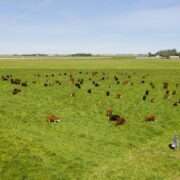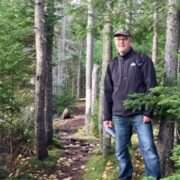
The VIMO farm, one of the farms on the Regeneration Canada https://regenerationcanada.org/fr/ferme-vimo/
On September 1st, I had the pleasure of attending the Massawippi Foundation’s Farm to Table luncheon. It was an opportunity for me to learn about the critical conservation work that the Foundation and the Trust are doing. I applaud the management of the Foundation and the Massawippi Conservation Trust for taking an unconventional stand in the conservation world and for recognizing the leadership of farmers doing regenerative agriculture as an essential contribution to the quality of the lake water and the environment.
I am the President of the Board at Regeneration Canada. Our organization, founded in 2017, is dedicated to raising awareness and supporting the transition to regenerative agriculture and land management as an important part of this country’s climate mitigation strategy. A growing number of people are becoming aware that cutting emissions alone will not combat climate change. We also need to restore the ecosystem functions on our planet, which draw greenhouse gases out of the atmosphere and store carbon in the land. Trees and plants breathe in greenhouse gases such as carbon dioxide and convert them to liquid carbon, which they exude through their roots to feed soil microbes. Soil microbes, in turn, transform the mineral nutrients from organic matter and make them accessible to the plants. This whole marvelous cycle is the basis of the soil ecosystem, Nature’s closed-loop system for recycling nutrients, creating fertility and filtering water. A healthy soil ecosystem, not only the trees, plays a vital role in balancing the carbon and the water cycles.
Conservation of forests, waterways and biodiversity is essential for restoring the natural functions which regulate our climate. Yet the population of humans which has taken over more and more of the surface of our planet over the centuries has altered the planetary ecosystems and unwittingly thrown these natural systems out of balance. So, of course, we must conserve the remaining natural spaces, but at the same time ,we have to meet the needs of the people who live around them.
Regenerative agriculture and land management is a way of meeting human needs while restoring ecosystem functions. It is possible by mimicking natural systems to create human-managed environments that provide us food and fibre while still sequestering carbon, purifying water and increasing biodiversity. This is the emerging science of the regenerative movement. A regenerative farming system does all these things by applying the principles of regenerative land management :
- Disturb the soil as little as possible and keep it covered with living plants as much of the year as possible;
- Integrate more trees and perennial plants into the production system;
- Diversify the number of species of plants grown;
- Transition from synthetic fertilizers and pesticides to natural amendments such as compost, manure and cover crops;
- Integrate animals into the system. This ranges from pasture grazing ruminants like cows and sheep, to pollinators, birds, and other wild creatures who can find habitat.
Regeneration Canada brings together pioneering regenerative farmers with environmentally conscious consumers looking to support regeneration in their buying choices through our map of regenerative farms. We welcome you to explore our map, sign up if you are a regenerative farmer, or join our network of citizens who are concerned about taking climate action.




